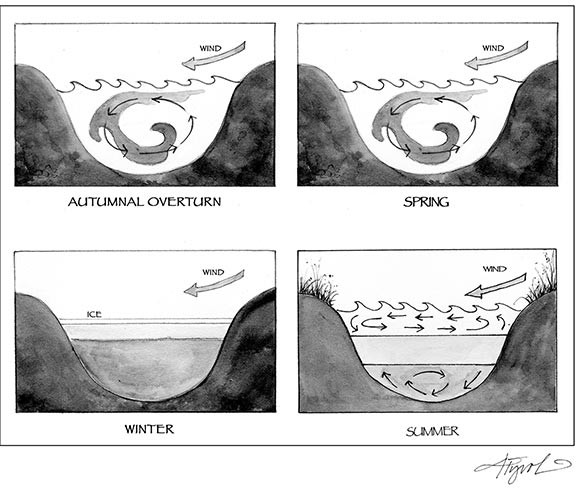
The onset of spring brings many changes to our part of the world. The longer days and higher temperatures entice plants to emerge and trees to bud. On our lakes, the ice begins to melt. We anticipate the water activities we’ll soon be enjoying: swimming, boating, and fishing. But the spring thaw is more than just a launching pad for recreational activities; it also triggers spring lake turnover, a critical phenomenon on which aquatic plant and animal life depends.
Spring lake turnover is the process by which a lake mixes itself, thereby replenishing its oxygen supply. Oxygen is vital for lake quality – it is the gas that drives the life cycles of aquatic plants and animals. Algae, fish, aquatic insects and crustaceans are sustained only in waters that contain adequate oxygen. Trout, in particular, require consistently high levels of oxygen for survival.
So how does a body of water accumulate oxygen? To understand, we must first be aware of the temperature-density relationship of water.
The density of water changes with temperature. We know that 212°F is the boiling point for water, and 32°F is freezing. A third significant number regarding water chemistry is 39°F – the temperature of maximum water density.
We’ll begin our spring lake turnover story in autumn. In the fall, a lake cools until it reaches a uniform 39°F. As the lake continues to cool it becomes stratified – the heavy, 39°F water stays on the bottom, while the water near the top is chilled by the below freezing air temperatures. Ice, less dense than water, forms when the lake’s surface temperature reaches 32°F. The ice acts as a barrier to wind, which prevents the lake water from mixing; it also inhibits the lake’s exchange with oxygen in the atmosphere. Once a lake is frozen, the depletion of oxygen by the lake organisms begins.
Just when the lake’s oxygen supply is nearly exhausted, spring arrives and the ice cover slowly melts, exposing the surface to warmer temperatures and vigorous vernal winds. The lake’s surface water begins exchanging gases with the air. When the surface water warms to 39°F, it sinks, pushing through the deeper water and infusing it with oxygen. This process creates a powerful convection current that continues to churn until all the lake water is an even 39°F, top to bottom, and the water has reached its oxygen saturation point (approximately 12 parts per million).
In late spring and early summer, solar energy warms the water’s surface. Warmer water, being less dense than colder water, remains on the surface and the lake once again begins to stratify. Swimmers routinely experience the phenomenon of summer stratification, usually preferring the warm layer of surface water to the more frigid depths below. Trout have the opposite preference.
Once summer stratification occurs, the lake water no longer mixes, and the depletion of oxygen reserves begins. The oxygen levels will continue to deplete until fall, when the air temperatures drop, the surface cools, and the lake water is again blended – and re-oxygenated – at 39°F. The cycle continues.

